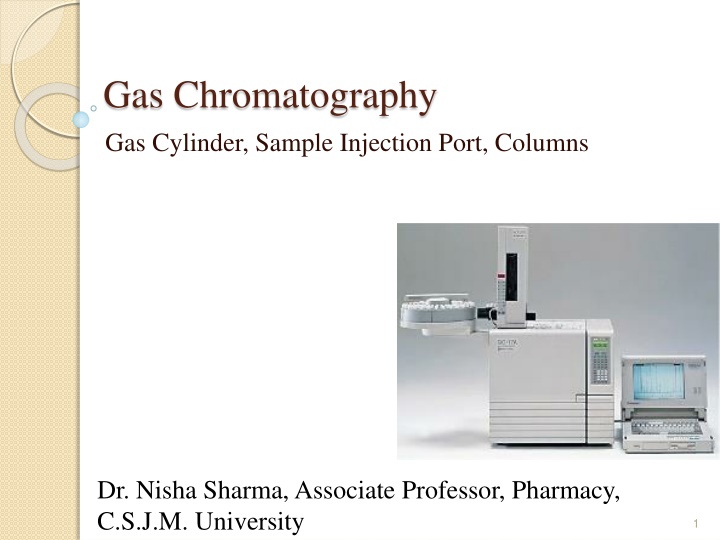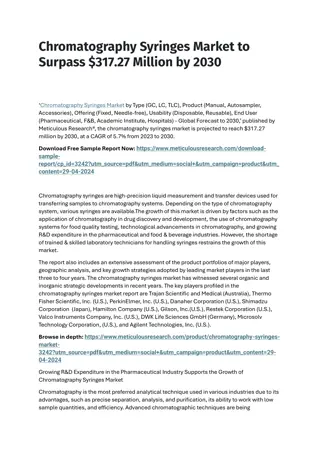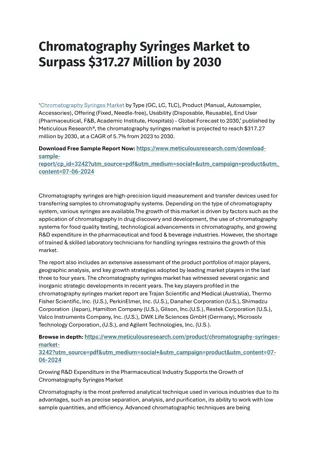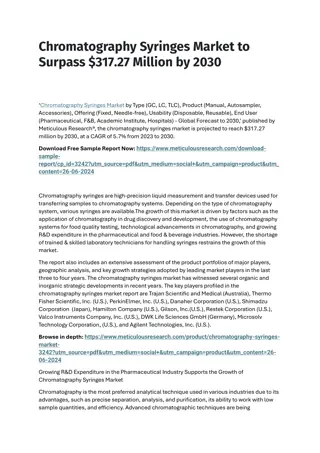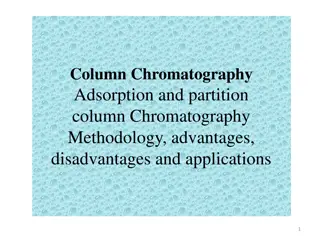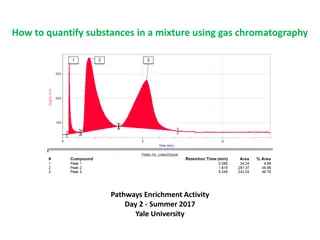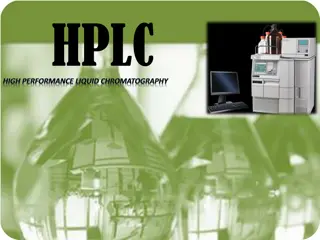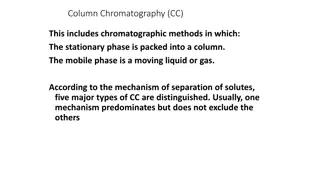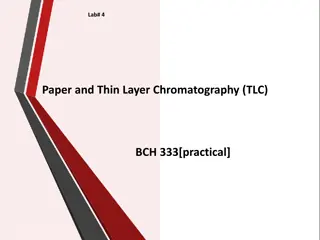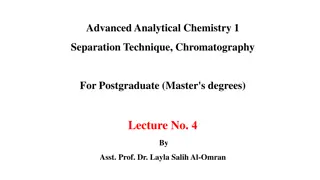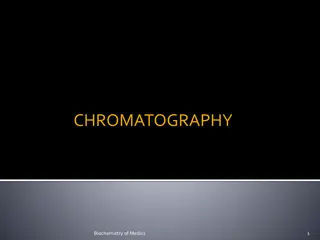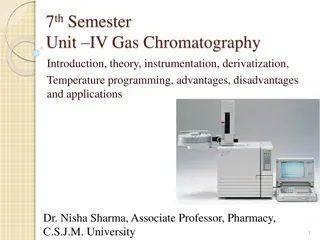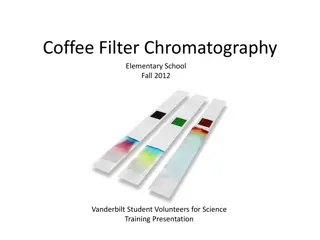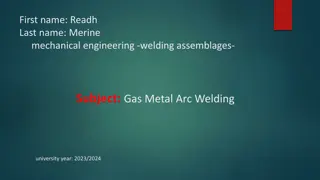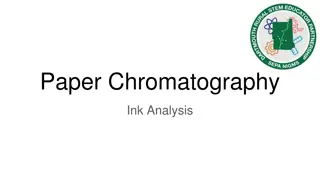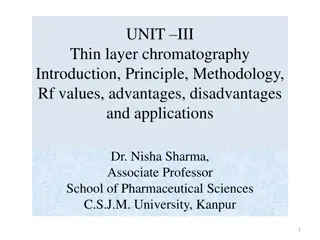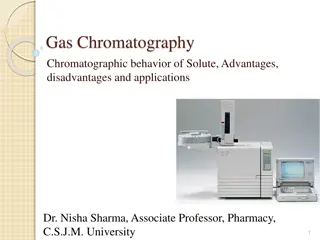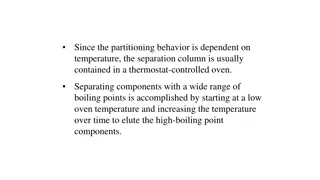Gas Chromatography Equipment Overview: Components and Functions
Gas chromatography involves various components like gas cylinders, sample injection ports, and columns. The gas cylinder serves as a carrier gas reservoir with a pressure regulator. Sample introduction is through a column inlet/sample port injector. The GC injection syringe helps vaporize samples quickly, and columns play a crucial role in separating compounds. Different types of columns, such as capillary and packed columns, are utilized in gas chromatography.
Download Presentation

Please find below an Image/Link to download the presentation.
The content on the website is provided AS IS for your information and personal use only. It may not be sold, licensed, or shared on other websites without obtaining consent from the author.If you encounter any issues during the download, it is possible that the publisher has removed the file from their server.
You are allowed to download the files provided on this website for personal or commercial use, subject to the condition that they are used lawfully. All files are the property of their respective owners.
The content on the website is provided AS IS for your information and personal use only. It may not be sold, licensed, or shared on other websites without obtaining consent from the author.
E N D
Presentation Transcript
Gas Chromatography Gas Cylinder, Sample Injection Port, Columns Dr. Nisha Sharma, Associate Professor, Pharmacy, C.S.J.M. University 1
Gas cylinder High pressure gas cylinder (gas in compressed) carrier gas reservoir. Pressure regulator- To & control gas flow. Soap bubble meter- To reproduce the rate of carrier gas. Soap film is formed in path of gas when a rubber bulb containing aq sol of soap or detergent if squeezed. Time req for soap film to move b/w 2 graduations on burette is measured & converted to flow rate. 2
Sample Introduction Column inlet-sample port injector. Solute-chrom-Vapor state. Inj port is heated to temp-rapid vaporization, but no thermal degradation of solute Construction of port- Heavy mass, maint at Temp. Sample should be intro immediately into column. Liq/gas sample- inj by syringe-0.1-100 L. Rapid inj. into gas stream. Liq- injected- near- as solutions with syringe-0.5-10 L. Solid- dissolved in suitable solvent-injected as solution. Injection of samples which can t be vaporised at operating temp. are avoided. B cos compds not move appreciably in liq or solid form may clog the port & damage the column. 3
G.C INJECTION SYRINGE: * To rapidly vaporize the sample. * Slow vaporization ses band broadening, by sing the sample plug . * Injection port temperature mostly held 50 C higher than BP of least volatile compd. 4
Columns: Heart of Instrument Glass/metal, 4-8 mm(D)- few cm-hundred mts.(L) Mounted in const. temp. oven, basic process takes place. Size: 6ft L, 1/4 I.D., Cu, SS tubing, U shaped. Coiled to spiral, saves space. Tubing- packed with inert, pulverized solid material of large surface area. (Diatomacious earth or firebrick) Solid is used as mechanical support to liq. Before packing solid mat. is impregnated with desired liq. Which serves as real stationary phase. Liq.- stable, Non vol. at temp. of column. 5
Types of Columns In GLC-2 types Capillary columns- form capillary tubing Bore coated with a thin film of liq. Phase 0.166 or less Dia., upto 200ft. L, sample capacity. Film of liq. is deposited on inner wall of tubing. Packed Columns: SS/Cu, tube packed with solid substrate- GSC- or a liq coating on inert solid (GLC), D of tube: 0.25 , L- 5-50 ft. Tubes- folded/coiled 6
Packed Capillary (Open Tubular) Columns metal, plastic, glass (FRAGILE), More recently: Fused Silica - robust, flexible Upto 200ft. L glass, metal (stainless), Cu, Teflon few meters in length, L- 5-50 ft few mm in diameter (i.d.), 0.25 . Int. col. Dia. Should be atleast 8 times D of support particles. Support Materials: small particles, uniform (spherical) shape, porous, inert. 100-300 m diameter diatomaceous earth, polymeric materials Small diameter (typically <500 m), 1/6 or less Support methods: Support-Coated OT (SCOT) Wall-Coated OT (WCOT) 7
Stationary Phase Materials Gas-Liquid Chromatography (GLC) Characteristics: appropriate chemical nature ( like dissolves like ) low volatility thermal stability chemical inertness Typical coatings (< 1 to several m thickness): Polyethylene Glycol (PEG, Carbowax) -(O-CH2-CH2-)n Poly(dialkyl)silane Vary R groups to vary retention characteristics 8
Most Common Stationary Phases 1. For Separation of mixture of polar compounds Carbowax 20M (polyethylene glycol) 2. For Separation of mixtures of non-polar compounds OV101 or SE-30 (polymer of methylsilicone) 3. For Methylester of fatty acids DEGS (diethylene glycol succinate) 9
Lifetime of column is limited by: adhesion of liquid coating to stationary phase (bleeding) irreversible adsorption of contaminants to column To Minimize the bleeding Cross-linking: on-column reaction Bonding : Utilize surface chemistry of column (or packing) Minimizing Adsorption Gas-solid Chromatography (GSC): Typically porous solid adsorbed to walls (OT) or a porous solid support molecular sieves Porous polymers (beads or coatings) 10
Gas Chromatography Packed Column 1/8 x 6 Packed column longitudinal cross section Gas Chromatography Capillary Column 250 m x 10m 11
Columns Most popular-capillary columns- WCOT column- fused-silica wall-coated (FSWC) open tubular column. Walls of fused-silica columns- made of purified silica containing minimal metal oxides. Much thinner than glass columns, Dia 0.1 mm & lengths as long as 100 m. To protect the column, a polyimide coating applied to outside of the tubing and bent into coils to fit inside the thermostatted oven of gas chromatography unit. FSWC columns commercially available, have increased chemical inertness, greater column efficiency and smaller sampling size requirements. It is possible to achieve up to 400,000 theoretical plates with a 100 m WCOT column, the world record for the largest number of theoretical plates is over 2 million plates for 1.3 km section of column.
PACKED Columns Packed columns are made of a glass or a metal tubing which is densely packed with a solid support like diatomaceous earth. Due to the difficulty of packing the tubing uniformly, these types of columns have a larger diameter than open tubular columns and have a limited range of length. As a result, packed columns can only achieve about 50% of the efficiency of a comparable WCOT column. Furthermore, the diatomaceous earth packing is deactivated over time due to the semi-permanent adsorption of impurities within the column. In contrast, FSWC open tubular columns are manufactured to be virtually free of these adsorption problems.
Depending on the type of sample, some GC columns are better than the others. Ex. FSWC column Designed specially for blood alcohol analysis. It produces fast run times with baseline resolution of key components in under 3 minutes. It displays enhanced resolutions of ethanol and acetone peaks, this helps in determining the BAC levels. Known as Zebron-BAC & made with polyimide coating on outside & inner layer is made of fused silica & inner diameter 0.18 mm to 0.25 mm. Ex. Of Zebron GC column known Zebron-inferno. Its outer layer is coated with a special type of polyimide that is designed to withstand high temperatures. It contains extra layer inside. It can withstand up to 430 C & designed to provide true boiling point separation of hydrocarbons distillation methods. Moreover, it is also used for acidic and basic samples.
